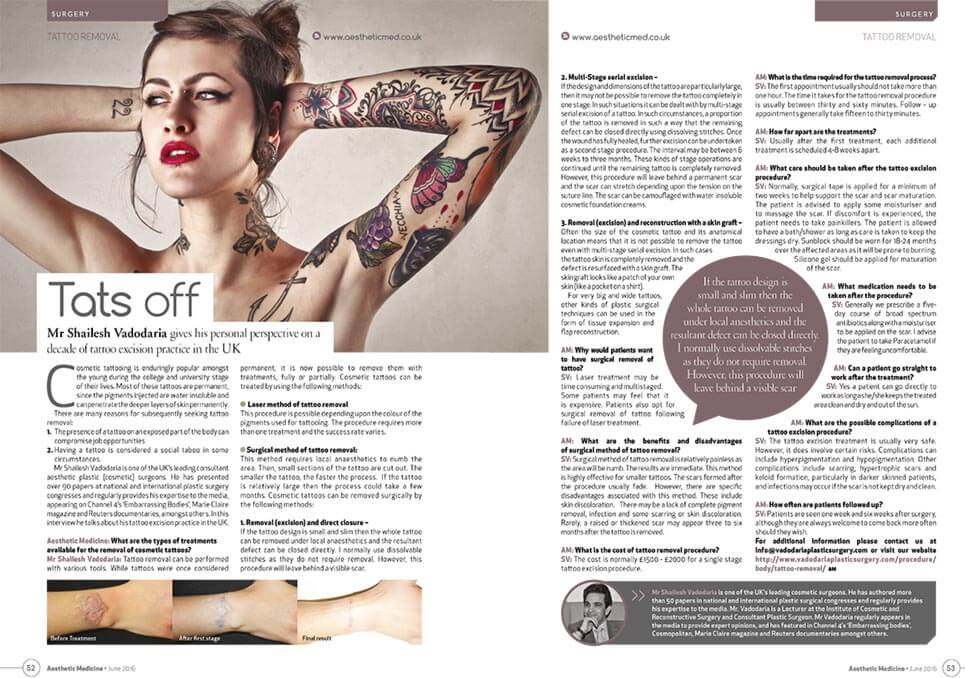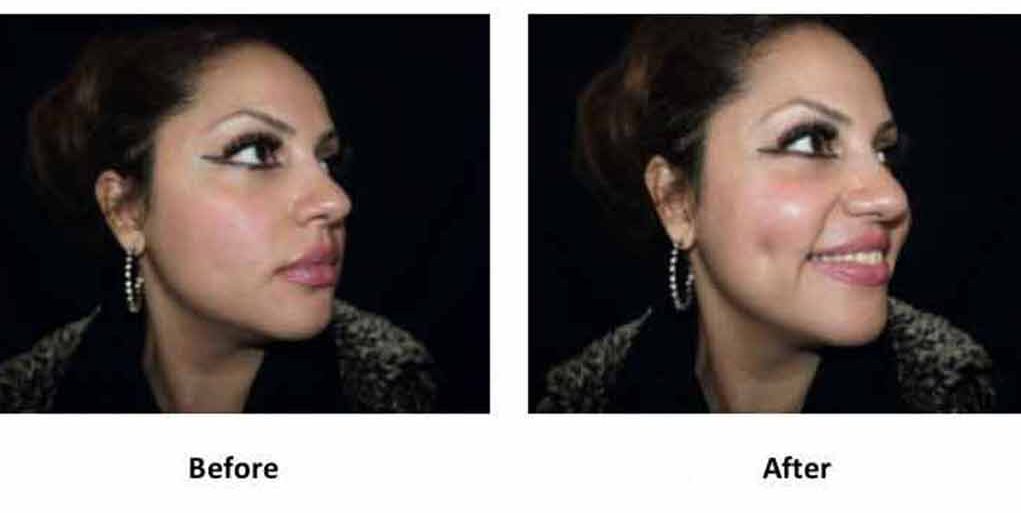Mr Shailesh Vadodaria gives his personal perspective on a decade of tattoo excision practice in the UK
Read more about tattoo removal at Medical Arts for Cosmetic Surgery Clinic. Article featured on www.aestheticmed.co.uk
Mr Shailesh Vadodaria gives his personal perspective on a decade of tattoo excision practice in the UK
Cosmetic tattooing is enduringly popular amongst the young during the college and university stage of their lives. Most of these tattoos are permanent, since the pigments injected are water insoluble and can penetrate the deeper layers of skin permanently. There are many reasons for subsequently seeking tattoo removal:
- The presence of a tattoo on an exposed part of the body can compromise job opportunities
- Having a tattoo is considered a social taboo in some circumstances. Mr Shailesh Vadodaria is one of the UK’s leading consultant aesthetic plastic (cosmetic) surgeons. He has presented over 90 papers at national and international plastic surgery congresses and regularly provides his expertise to the media, appearing on Channel 4’s ‘Embarrassing Bodies’, Marie Claire magazine and Reuters documentaries, amongst others. In this interview he talks about his tattoo excision practice in the UK.
Aesthetic Medicine – What are the types of treatments available for the removal of cosmetic tattoos? Mr Shailesh Vadodaria: Tattoo removal can be performed with various tools. While tattoos were once considered permanent, it is now possible to remove them with treatments, fully or partially. Cosmetic tattoos can be treated by using the following methods:
- Laser method of tattoo removal This procedure is possible depending upon the colour of the pigments used for tattooing. The procedure requires more than one treatment and the success rate varies.
- Surgical method of tattoo removal: This method requires local anaesthetics to numb the area. Then, small sections of the tattoo are cut out. The smaller the tattoo, the faster the process. If the tattoo is relatively large then the process could take a few months. Cosmetic tattoos can be removed surgically by the following methods:
- Removal (excision) and direct closure —If the tattoo design is small and slim then the whole tattoo can be removed under local anaesthetics and the resultant defect can be closed directly. I normally use dissolvable stitches as they do not require removal. However, this procedure will leave behind a visible scar.
- Multi-Stage serial excision – If the design and dimensions of the tattoo are particularly large, then it may not be possible to remove the tattoo completely in one stage. In such situations it can be dealt with by multi-stage serial excision of a tattoo. In such circumstances, a proportion of the tattoo is removed in such a way that the remaining defect can be closed directly using dissolving stitches. Once the wound has fully healed, further excision can be undertaken as a second stage procedure. The interval may be between 6 weeks to three months. These kinds of stage operations are continued until the remaining tattoo is completely removed. However, this procedure will leave behind a permanent scar and the scar can stretch depending upon the tension on the suture line. The scar can be camouflaged with water insoluble cosmetic foundation creams.
- Removal (excision) and reconstruction with a skin graft -Often the size of the cosmetic tattoo and its anatomical location means that it is not possible to remove the tattoo even with multi-stage serial excision. In such cases the tattoo skin is completely removed and the defect is resurfaced with a skin graft. The skin graft looks like a patch of your own skin (like a pocket on a shirt). For very big and wide tattoos, other kinds of plastic surgical techniques can be used in the form of tissue expansion and flap reconstruction.
AM: Why would patients want to have surgical removal of tattoo?
SV: Laser treatment may be time consuming and multistaged. Some patients may feel that it is expensive. Patients also opt for surgical removal of tattoo following failure of laser treatment.
AM: What are the benefits and disadvantages of surgical method of tattoo removal?
SV: Surgical method of tattoo removal is relatively painless as the area will be numb. The results are immediate. This method is highly effective for smaller tattoos. The scars formed after the procedure usually fade. However; there are specific disadvantages associated with this method. These include skin discoloration. There may be a lack of complete pigment removal, infection and some scarring or skin discoloration. Rarely, a raised or thickened scar may appear three to six months afterthe tattoo is removed.
AM: What is the cost of tattoo removal procedure?
SV: The cost is normally £1500 – £2000 for a single stage tattoo excision procedure.
AM: What is the time required for the tattoo removal process?
SV: The first appointment usually should not take more than one hour. The time it takes for the tattoo removal procedure is usually between thirty and sixty minutes. Follow – up appointments generally take fifteen to thirty minutes.
AM: How far apart are the treatments? SV: Usually after the first treatment, each additional treatment is scheduled 4-8 weeks apart.
What care should be taken after the tattoo excision procedure?
SV: Normally, surgical tape is applied for a minimum of two weeks to help support the scar and scar maturation. The patient is advised to apply some moisturiser and to massage the scar. If discomfort is experienced, the patient needs to take painkillers. The patient is allowed to have a bath/shower as long as care is taken to keep the dressings dry. Sunblock should be worn for 18-24 months over the affected areas as it will be prone to burning. Silicone gel should be applied for maturation of the scar.
AM: What medication needs to be taken after the procedure?
SV: Generally we prescribe a five-day course of broad spectrum antibiotics along with a moisturiser to be applied on the scar. I advise the patient to take Paracetamol if they are feeling uncomfortable.
AM: Can a patient go straight to work after the treatment?
SV: Yes, a patient can go directly to work as long as he/she keeps the treated area clean and dry and out of the sun.
AM: What are the possible complications of a tattoo excision procedure?
SV: The tattoo excision treatment is usually very safe. However, it does involve certain risks. Complications can include hyperpigmentation and hypopigmentation. Other complications include scarring, hypertrophic scars and keloid formation, particularly in darker skinned patients, and infections may occur if the scar is not kept dry and clean.
AM: How often are patients followed up?
SV: Patients are seen one week and six weeks after surgery, although they are always welcome to come back more often should they wish.
Mr Shailesh Vadodaria is one of the UK’s leading cosmetic surgeons. He has authored more than 50 papers in national and international plastic surgical congresses and regularly provides his expertise to the media. Mr. Vadodaria is a Lecturer at the Institute of Cosmetic and Reconstructive Surgery and Consultant Plastic Surgeon. Mr Vadodaria regularly appears in the media to provide expert opinions, and has featured in Channel 4’s ‘Embarrassing bodies’, Cosmopolitan, Marie Claire magazine and Reuters documentaries amongst others.




